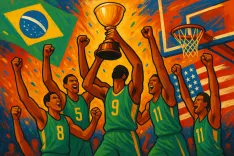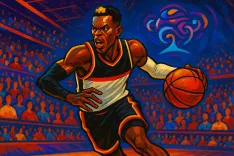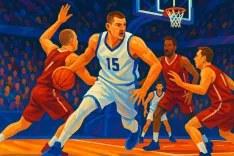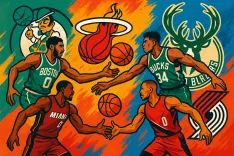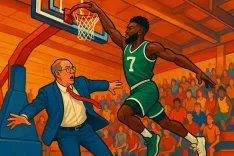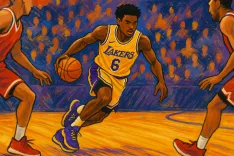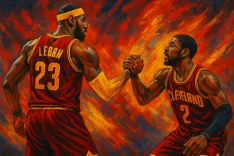Examining the 2025 NBA Playoffs: Winners and Losers

As the 2025 NBA Finals approach, the playoffs have already provided a plethora of remarkable highlights, competitive series, and defining performances that encapsulate the current era. While there are still memorable moments yet to unfold, the postseason has delivered a wealth of narratives to analyze. This examination will explore the most significant stories through a classic 'winners and losers' framework.
Historically, the Boston Celtics, Chicago Bulls, Golden State Warriors, Los Angeles Lakers, and Philadelphia 76ers have dominated the NBA Finals, collectively making 43 appearances since the NBA-ABA merger in 1976. However, this season has seen a stark departure from this trend, as the 76ers and Bulls failed to qualify for the playoffs. The Lakers experienced an early exit in the first round, while both the Warriors and Celtics were eliminated in the second round. Even the New York Knicks, representing the league's largest media market, were sent home after reaching the conference finals. Unlike the NFL, which has cultivated a culture of parity, the NBA has traditionally been characterized by dynasties, legacies, and prominent franchises contesting for championships. The upcoming Finals will break this narrative with the Indiana Pacers and Oklahoma City Thunder, teams hailing from smaller markets, competing for the title.
The ongoing discussion regarding the efficacy of having the best player in a series or a formidable trio as the key to success also comes into question. Owen Phillips, a writer for The F5 newsletter, has highlighted that basketball operates as a strong link sport, meaning that typically, the team with the best player prevails. While this remains true, the postseason has revealed that depth is essential. The Thunder and Pacers, now the only remaining teams, showcased their depth by utilizing nine or ten players effectively throughout the playoffs. This depth is crucial in minimizing weak links on the court, a factor that can negate the efforts of a team's top players. As the league transitions into an era favoring depth over star power, teams that overextend their resources on a few stars may find themselves vulnerable to the exploitation of weaker players. Players like LeBron James and Stephen Curry, who have historically represented glamour markets, have seen their championship aspirations dwindle. The paths of dynamic players such as Kevin Durant, Chris Paul, and Damian Lillard have also diverged this postseason, with several veterans failing to advance deep into the playoffs while younger talent emerges. A new generation of players is beginning to take center stage, including reigning MVP Shai Gilgeous-Alexander, Jalen Williams, and Chet Holmgren.
Despite the conversation surrounding player mortality and potential downturns in performance, there remains a pool of up-and-coming talent poised to extend the league's legacy. This postseason has introduced fans to standout young players like Anthony Edwards, Tyrese Haliburton, and Giannis Antetokounmpo, who remain in their prime. Additionally, Luka Dončić and Boston's Jayson Tatum and Jaylen Brown, still in their twenties, assure a bright future for the league. As the NBA has showcased in the past, it will naturally cultivate its next star just as historically dominant players transitioned through the league. The increasing discussions around the length of the NBA season may also be reflective of the toll taken on player health, particularly in light of injuries sustained by key players.
The 82-game regular season has long been a staple of the NBA, offering a true test of endurance and skill. While some argue for a reduction in game number to curb injuries, there are counterpoints regarding the historical significance of individual player records. This year’s outcomes, including the injuries to prominent figures like Tatum and Lillard, have fueled the debate. Yet, amidst concerns, the league has garnered intrigue through initiatives like the in-season tournament, which may provide an alternative means of engagement, as observed through the Pacers' and Thunder's playoff runs. The Pacers, in particular, displayed resilience after an unexpected conference finals appearance the previous year, entrusting their roster and depth, which ultimately propelled them to the Finals.
The Cleveland Cavaliers, despite a stellar regular season finishing with a 64-18 record, may find themselves labeled as disappointments after their swift exit from the playoffs. The Cavaliers featured a roster that included several top-tier talents but ultimately struggled to leave a mark after losing to the Pacers in five games. The offseason may bring questions regarding the fit between their key players and potential transactions to enhance their competitiveness moving forward. In contrast, the Pacers demonstrated the importance of patience and strategic roster management, leading them to a successful playoff campaign bolstered by notable performances from players like Pascal Siakam and Tyrese Haliburton.
On the other hand, the Denver Nuggets faced their own setbacks and disappointment by failing to progress beyond the second round and subsequently changing their coaching staff. Despite these challenges, Nikola Jokić's performance underscored the potential for strong link dynamics in basketball, as he consistently produced elite numbers throughout the series against Oklahoma City. As the playoff picture develops, a lingering aura of optimism surrounds Jokić and the Nuggets, even if they were ultimately eliminated. Teams like the Thunder have exhibited remarkable consistency and excellence, showcasing a deep roster and dynamic play throughout the postseason. With strong performances and historical achievements, the Thunder are positioned as the frontrunners for the title, setting the stage for an exciting conclusion to the playoffs.

